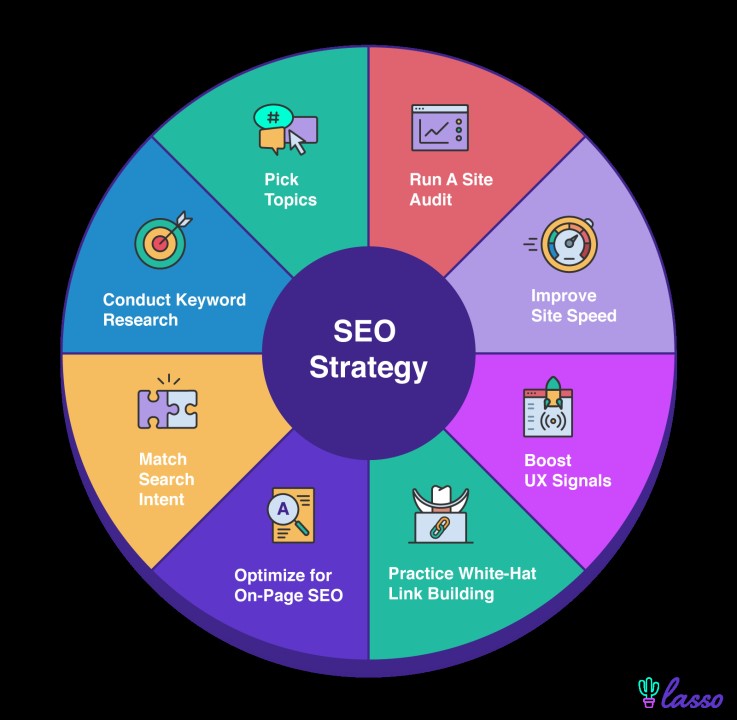Advanced SEO Techniques & Strategies involve broad methods and approaches that go beyond basic SEO procedures in order to significantly improve a website’s search engine ranking, visibility and user engagement.
These strategies typically call for a deeper understanding of user behavior, search engine algorithms and recent advancements in digital marketing.

Advanced SEO Techniques & Strategies
1.Content Marketing and SEO
SEO and content marketing go hand in hand. Effective SEO requires high-quality content since search engines give preference to user-relevant and valuable information. Here are a few advanced strategies:
- SEO and content marketing go hand in hand. Effective SEO requires high-quality content since search engines give preference to user-relevant and valuable information. Here are a few sophisticated tactics:
- Topic Clusters and Pillar Pages: Arrange content according to relevant subtopics (cluster content) and core topics (pillar pages). This improves relevance for more general themes and aids search engines in comprehending the content structure.
- E-A-T stands for Expertise, Authority, and Trustworthiness. Create content that demonstrates your knowledge and authority in the industry. To foster confidence, provide author biographies and cite reliable sources.
- Content Refreshing: To maintain current content correct and relevant, refresh it frequently. By doing this, out-of-date content may rank higher.
- Long-form material typically ranks higher in search results.
- User Intent: Pay close attention to deciphering and attending to the intentions behind search inquiries. Provide material that specifically addresses the inquiries and demands of your intended audience.
2.International SEO
You may increase your worldwide reach by making your website responsive to many browsers and languages. The following are some advance strategies:
- Use hreflang tags to tell search engines what language and location you are targeting. This aids in providing the appropriate content to the appropriate audience.
- Local Content: Provide information that speaks to the interests of your intended global audience while also being culturally appropriate.
- Use Google Search Console’s geo-targeting feature to indicate the nation that your website is aimed at.
- URL Structure: Depending on your demands, select a suitable URL structure (such as ccTLDs, subdomains, and subdirectories) for foreign websites.
- Language-Specific Keywords: Research keywords for every language you intend to target and adjust your content accordingly.
- Technical SEO: Make sure your website is mobile-friendly, has a strong infrastructure to support visitors from around the world and loads quickly.
3.Video SEO
With the growing popularity of video content, optimization for search engines of videos can greatly increase visibility. Here are a few advanced strategies:
- Keyword Research for Videos: To identify pertinent video terms, use resources like Google Trends, YouTube’s autocomplete feature, and keyword planners.
- Metadata optimization: Use certain keywords to enhance the titles, descriptions, and tags of your videos. Make sure the descriptions are thorough and contain pertinent links.
- Closed captions and transcripts: Give your videos closed captions and transcripts. This improves accessibility and aids in search engines comprehending the video material.
- Personalized thumbnails: Make use of captivating, superior bespoke thumbnails to boost click-through rates.
- Video Sitemaps: To ensure that search engines correctly index your video content, submit video sitemaps to them.
4.Voice Search Optimization
Voice search optimization is becoming more and more crucial as smart speakers and voice assistants become more common. The following are some advanced strategies:
- Natural Language: Since voice searches tend to be more in-depth and conversational, optimize your content for natural language questions.
- Aim for featured snippets for your material, as voice assistants frequently read these aloud in response to spoken questions.
- Local SEO: Make sure your company is optimized for local search with correct NAP (Name, Address, Phone number) information. Voice searches frequently contain local intent.
- Content Based on Questions: Provide content that responds to frequently asked queries from your target audience. Employ interrogative phrases such as “who,” “what,” “where,” “when,” and “how.”
